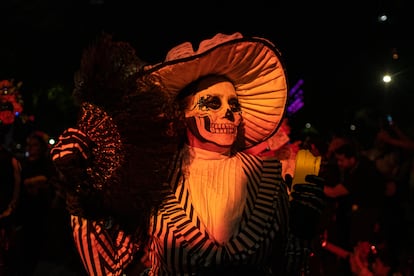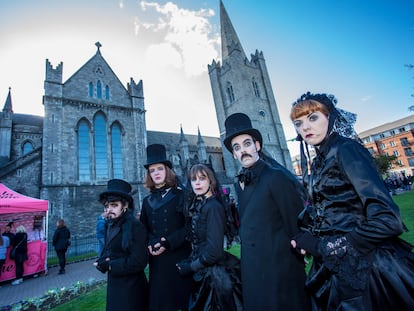The story of La Catrina, a Mexican tradition that began as a social critique
The character, a satirical portrayal of bourgeois society during the late 19th-century dictatorship, is now the iconic symbol of the Day of the Dead


Mexican marigolds (cempasúchil), private altars (ofrendas) and La Calavera Catrina (the Dapper Skull) have become essential symbols of the Day of the Dead, a holiday traditionally celebrated on November 1 and 2 in Mexico. Each year, the elegantly dressed La Catrina skeleton takes the spotlight in parades and costume parties. But the original purpose of La Catrina envisioned by its creator, Mexican printmaker and lithographer José Guadalupe Posada, was to critique bourgeois society during the late 19th-century dictatorship of Porfirio Díaz, when the extravagant silk attire of well-to-do Mexicans starkly contrasted with the harsh reality faced by most of the country.
La Catrina’s original name was la calavera garbancera, a pejorative term for people who denied their Indigenous roots and imitated the European fashions of the day. Posada, who was born in Aguascalientes in 1852, created illustrations and lithographs for the working class. He often used calacas (a colloquial Mexican name for skeleton) to depict the joys and challenges of everyday life, and to satirize those who became wealthy during the 30-year Díaz dictatorship known as the Porfiriato (1876-1911). One of his most memorable prints is a skull wearing a flamboyant French hat embellished with flowers and ostrich feathers. It mocks high-society women who proudly flaunted extravagant fashion accessories, yet were as empty as skeletons inside.
Posada was a highly productive artist who established his Mexico City workshop in 1888, and passed away unnoticed in 1913. Muralist Diego Rivera’s reimagining of Posada’s creations finally brought him the recognition he deserved as one of the foremost figures in Mexican popular art. “Undoubtedly, the Mexican bourgeoisie was terribly unlucky in having the brilliant and incomparable Posada as a critical narrator of its ways,” wrote the muralist about his inspiring predecessor.
In 1946-47, Rivera painted A Dream of a Sunday Afternoon in the Alameda Park, a fresco that featured a fully elaborated figure of La Catrina. The mural was a commission for the Hotel del Prado in Mexico City and features several legendary figures from Mexican history. Rivera gave his Catrina Indigenous features and thus transformed her into a nationalist icon. The elegant skeleton stands in the center, holding hands with its creator — José Guadalupe Posada. “Posada’s greatness is such that his name may one day fade from memory. It has become so deeply rooted in the essence of Mexico that it verges on abstraction. Yet his art and legacy courses through the veins of young Mexican artists, whose works blossom like vibrant flowers in a spring field,” wrote Rivera, who gave Posada’s character her name — La Catrina.
La Catrina transcended art and became a vibrant manifestation of Mexican culture. Affectionately known as la flaca (skinny), she no longer wears European finery, but adorns herself instead in flower diadems, huipiles (traditional Indigenous garments) and the flashy charro outfits of Mexican cowboys. Mexicans have eagerly embraced the spectral figure as a way to find solace and even celebrate the ephemeral nature of life on the Day of the Dead.
Sign up for our weekly newsletter to get more English-language news coverage from EL PAÍS USA Edition









































